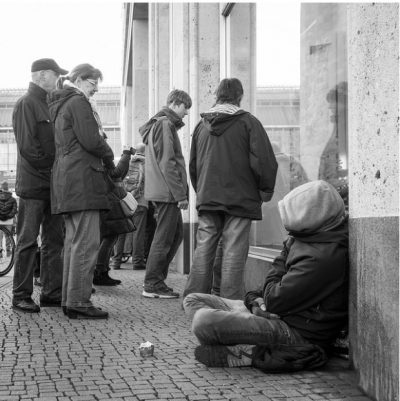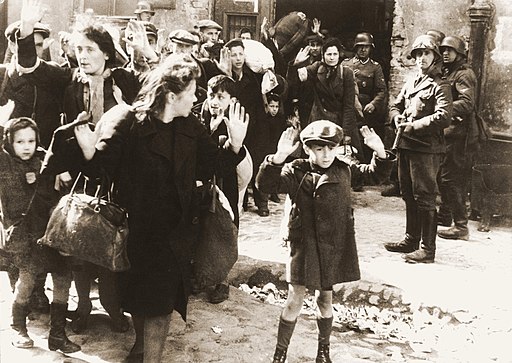14.4 Justice
L D Worthy; T Lavigne; and F Romero
An essential part of morality involves determining what is considered “right” or “fair” in social interactions. As humans, we want things to be fair, we try to be fair ourselves, and we react negatively when we see things that are unfair. There is cultural variation regarding fairness because we determine what is or is not fair by relying on another set of social norms; the beliefs about how people should be treated fairly (Tyler & Lind, 2001; Tyler & Smith, 1998).
Most of us are familiar with the concept of equality, which suggests that everyone is treated the same and provided the same resources to succeed. For example, a health clinic in a small village can be open to everyone, but some villagers may lack the means to get to the village, or may not be able to afford medication. In this scenario, equality of health services has created a disparity of care – is that fair?
Another example that most of you are familiar with is applying for a job online. Most organizations, regardless of size almost exclusively use online recruitment and application processes which provides one system that everyone can use to apply for a job. One system and one platform that is the same for everyone – that’s equality, right? Except that the online application process may not be compatible with screen readers for the visually impaired and blind or the hiring algorithm may exclude you because of that D you earned in math. An underlying assumption of equality is that everyone starts in the same place and equally benefits from the same supports, which may or may not be the case.

Equity means ensuring that resources are equally distributed based on needs (Omrani-Khoo et al., 2013). Equity requires accounting for historical and current inequalities among groups of people who have been marginalized, excluded or experienced institutional discrimination. In this way, the concept of fairness is then based on the social and historical context. In our example about the clinic, health care workers might provide mobile care to reach villagers who cannot come to the clinic. They might also dispense medication on a sliding scale of payment so poor patients can get the treatment they need. When applying for a job, alternative applications and formats can be available for persons with disabilities when applying for jobs. The underlying assumption of equity is that everyone starts from a different place and receives the specific support and accommodations needed to produce fairness.
Equality and equity are separate constructs and sameness does not always translate into fairness, particularly across cultures. Justice, refers to the legal or philosophical perspective through which fairness is administered for the distribution of wealth, opportunities for personal activity, and social privileges. Current social justice efforts emphasize removing obstacles and underlying systemic barriers so that inequity is addressed and everyone receives equal access and resources. In the online application example, employers could ensure that their online platform is compatible with screen readers, videos have closed captions, fonts, colors and contrast can be adjusted to facilitate the process for individuals of all abilities.
One type of social fairness, known as distributive justice, refers to our judgments and perceptions about whether and how available rewards (resources) and costs are shared by (distributed across) group members. For example, if two people work equally hard on a project, they should get the same grade on it but if one works harder than the other, then the more hardworking partner should get a better grade. Distributive fairness is based on our perceptions of equity and is shaped by cultural norms.
Berman and colleagues (1984) presented American and Indian participants with a scenario about how to distribute a company bonus to employees. Findings revealed that American workers distributed the bonus based on equity norms (individual contributions to the company); whereas, the Indian workers distributed the bonus along need-based norms.

[Image by krzyboy2o Children Sharing a Milkshake CC BY 2.0, https://commons.wikimedia.org/wiki/File:Children_sharing_a_milkshake.jpg]
Recent research found that when presented with an uneven number of items, children tend to throw one item away rather than share the item unequally between two people they did not know. Paulus (2015) conducted a cross-cultural study to determine whether inequality aversion (e.g., throwing away rather than unequally sharing) is a universal concept. Results revealed that 6-7-year-old children in South Africa and the United States were more likely to throw out a resource rather than distribute it unequally. We might think of this as ‘better to be fair’. Ugandan children were more likely to distribute the resource even if it was unequally distributed. We might think of this as ‘wrong to waste’. These results challenge inequality aversion as a universal and suggests that there are cross-cultural differences in how children’s fairness-related decision making develops.
Things seem fair and just when we see that balances in rewards and costs are occurring, but things seem unfair and unjust when rewards and costs are not balanced. The preference for fairness has been proposed to be a basic human impulse (Tyler & Blader, 2000), and when we perceive unfairness, we also experience negative emotional responses in brain regions associated with reward and punishment (Tabibnia, Satpute, & Lieberman, 2008). The experience of unfairness is associated with negative emotions, including anger and contempt, whereas fairness is associated with positive emotions.
Humans believe in the importance of fairness in part because if we did not, then we would be forced to accept the fact that life is unpredictable and that negative things can occur to us at any time. Believing in fairness allows us to feel better because we can believe that we get what we deserve and deserve what we get (e.g., just world hypothesis). These beliefs allow us to maintain control over our worlds. To believe that those who work hard are not rewarded and that accidents happen to good people forces us to concede that we too are vulnerable.
One way to create a “just world” is to reinterpret behaviors and outcomes so that the events seem to be fair and one way that people do this is by blaming the victim (Lerner, 1980). Blaming the victim means interpreting the negative outcomes that occur to others internally so that it seems that they deserved them. When we see that bad things have happened to other people, we tend to blame the people for them, even if they are not at fault. We may believe that poor people deserve to be poor because they are lazy, that crime victims deserve to be victims because they were careless, and that people with AIDS deserve their illness. In fact, the more threatened we feel by an apparent unfairness, the greater is our need to protect ourselves from the dreadful implication that it could happen to us, and the more we disparage the victim.

We learned earlier about infrahumanization, which is the tendency to see outgroups as less human or as having less humanity. Infrahumaziation refers to attitudes and beliefs and dehumanization refers to behaviors that undermine the individuality, humanness and rights of others. Denying humanity in others can lead to moral judgements and dehumanization may be a consequence, as well as a cause of harmful behavior against individuals deemed as immoral (Bastian, Laham, Wilson, Haslam, & Koval, 2010; Bastian et al., 2011). For example, someone who violates social, cultural, religious norms can be viewed as immoral, which can initiate sanctions (formal and informal) as well as violence. Once an individual or group is found less human or immoral, treating them differently is seen as justified, ethical and natural. For this reason, dehumanization is viewed as a central component to intergroup violence because frequently groups or individuals who are considered immoral are treated unfairly.

Members of a minority group or other marginalized individuals and groups (e.g., sexual orientation, gender, disability, class, heritage, race) are susceptible and vulnerable to various forms of dehumanization. The Jewish Holocaust during World War II and slavery in the United States are infamous examples of dehumanization at its extreme.

